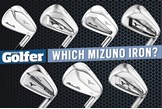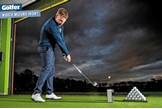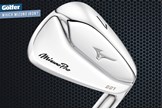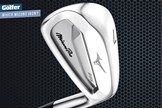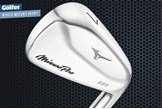Best Mizuno Irons 2024
Published: Last updated:
What are the best Mizuno irons for your golf game? This is your guide to each iron in Mizuno’s range, who they’re aimed at, and how they performed when tested by our pro.
JUMP TO: Best Mizuno Irons | The data | How we test | Buying advice
Mizuno have been making some of the best golf irons for decades, with many golfers believing the Japanese brand are simply unmatched in terms of looks, feel, and quality.
Mizuno’s best blade golf clubs have long been the preferred choice of many elite players, but Mizuno cater for all types of golfers, with a range of irons for different ability levels and handicaps. Today, we’ve found Mizuno also make some of the best irons for mid-handicaps and even some of the most forgiving irons for high handicaps.
Whatever your handicap and preference when it comes to irons, our comprehensive guide will help you pick the best Mizuno irons for your game.
Best Mizuno muscleback blade iron: Mizuno Pro 241 – View Offer UK
Best Mizuno tour iron: Mizuno JPX923 Tour
Best Mizuno players’ iron: Mizuno Pro 243 – View Offer UK
Best Mizuno players distance iron: Mizuno Pro 245 – View Offer UK
Best Mizuno iron for forgiveness: Mizuno JPX923 Hot Metal
Best Mizuno iron for slow swing speeds: Mizuno JPX923 Hot Metal HL
Video: Which Mizuno JPX923 Hot Metal iron suits you?
Best Mizuno Irons


The 241s predecessor (the Pro 221) was a former blade of the year here at TG but back in 2022, the model set golfers back £165 a club (or £1155 for a 7-piece set). As lovely as this new 241 model is at £200 a club a 7-piece set will now set you back £1400 which is a very punchy price for Mizuno blades.
Compared to other blades the 241 has a micro-thin copper coating under its chrome finish which Mizuno says gives the feel and matches the production process of their legendary irons from the 80’s.
Interestingly in terms of data even though the model has the same 7-iron loft as the JPX923 Tour iron, thanks to having zero ball speed protection tech the 241 produced 3.7mph less speed and 4 yards less carry distance. The model also hit shots into an area 28% bigger than the JPX923 Tour, which hopefully should spell out that golfers need to think carefully about plumping for this model.
Very few golfers ever need a set of muscleback blades, only 10% of tour pros chose them for their own game, but if you find yourself trying to choose between the 241 and JPX923 Tour focus on the type of shots you like hitting.
Mzuno say thanks to the slightly shorter blade length and lack of any cavity back or perimeter weighting the 241 typically falls into the hands of elite golfers who like to shape approaches into greens. Where the JPX923 Tour is a better fit for modern golfers who like to hit lots of straight shots.
Read our full Mizuno Pro 241 review.
TG Test Pro Data:
Ball Speed: 117.3 MPH / Launch Angle: 17.6° / Backspin: 5547 RPM / Peak Height: 30 YDS / Descent Angle: 44.3° / Carry Distance: 171 YDS / Shot Area: 218.9 SQ YDS
Pros
- Just look at them
- Fantastic feel
- Timeless classics
- Decent distance for traditional lofts
Cons
- Very little forgiveness
- Need good speed and strike to use them
| Category: | Muscleback Blade |
| Handicap range: | Four and below |
| Construction: | Forged from a single piece of 1025E HD Mild Carbon Steel |
| 7-Iron loft: | 34° |


Very much a modern muscle cavity, which tons of tour players nowadays swear by. Mizuno say golfers who plump for the Tours (over the Pro 241) are generally point-and-shoot golfers. That’s players who see shots in straighter lines with the ball falling one side or the other of their target line, and not traditional shot shapers, who are much more comfortable swinging shots in with a preferred shape.
Mizuno’s website has the Tours down as a good match for 0 - 4 handicap golfers, they’re more workable (so less forgiving) than the Pro 243, which should say almost everything you need to know about this elite players’ iron.
In 2024 really good golfers are likely to find themselves choosing between the Tour and the beautiful new Pro 243. Our test data shows a fraction more launch, spin, shot height, and descent angle in favor of the 243 which most golfers should be swayed by.
If you still find yourself drawn to the JPX923 Tour, the model approaches its second birthday in 2024, so it’s highly likely there will be replacements appearing towards the back end of the year.
If you’re good enough to play irons at this level it’s worth noting going any further up the Mizuno line-up you get heads made from springy chromoly steel, which absolute purists would argue isn’t quite the same as the 1025 E material, that gave birth to the brands “nothing feels like a Mizuno” tagline.
Read our full Mizuno JPX923 Tour iron review.
TG Test Pro Data:
Ball Speed: 121 MPH / Launch Angle: 16.2° / Backspin: 5704 RPM / Peak Height: 30 YDS / Descent Angle: 44.6° / Carry Distance: 175 YDS / Shot Area: 171 SQ YDS
Pros
- Great looks and feel
- Strong option for elite ball-strikers
- Shots stop quickly on the green
Cons
- Less forgiving than some cavity backs
| Category: | Player’s Iron |
| Handicap range: | Four and below |
| Construction: | Forged from a single piece of 1025E HD Mild Carbon Steel |
| 7-Iron loft: | 34° |


The popularity of forged tour level and muscle cavity irons has risen dramatically over the last few years. So much so pretty much all brands who sponsor tour players now want a super compact forged cavity back within their line-up.
But thanks to the 7-iron loft of the 243 being quite strong in the players’ iron market I would recommend seeing the Pro 243 as an alternative to irons like the Titleist T150 and Srixon ZX7 MK II rather than scrapping head on with weaker lofted and more tour focused models like the TaylorMade P7MC and Titleist 620 CB.
Compared to other players’ irons our 2024 test data doesn’t have the 243 ripping up any trees in terms of performance but our test pro was adamant, thanks to the looks, feel, and feedback the model had to feature among our five award-winning players’ irons of the year.
To get the best out of this compact head you’re going to need to be a consistent ball striker, and I love the way it has a slightly flatter appearance at address which really good golfers enjoy as it eliminates the feeling shots are going to be smothered left of their target (for a right-hander).
If you insist your game is best served by an elite-level forged cavity back iron, the Pro 243 is an absolute beauty. If you’re drawn to this model make sure you also take the time to consider how it compares to Mizuno’s brilliant hollow body Pro 245.
Although our test pro didn’t see huge amounts of difference between the pair some golfers will find the stronger loft, fast face, and more forgiving 245 head will be more playable on the golf course.
Read our full Mizuno Pro 223 iron review.
TG Test Pro Data:
Ball Speed: 122.2 MPH / Launch Angle: 16.6° / Backspin: 6035 RPM / Peak Height: 32 YDS / Descent Angle: 46.3° / Carry Distance: 174 YDS / Shot Area: 387 SQ YDS
Pros
- Excellent sound and feel
- Perfect for combo sets
- Lovely head shape and profile
Cons
- When did Mizuno irons become so expensive?
| Category: | Players’ Iron |
| Handicap range: | Six and below |
| Construction: | 4 - 7 iron one piece forged 4120 Chromoly steel, 8 – GW forged 1025 E mild carbon steel |
| 7-Iron loft: | 32° |


Mizuno reckons the Forged are often a good fit for 10 - 14 handicappers, and I’d say thanks to the pretty low offset in the longer irons not to go above that, certainly not if your swing speed is on the more moderate side of average (as extra offset helps flight shots higher).
The Forged is a brilliant mix of what lots of reasonable club golfers look for in a set of irons, so you have to see this lively chromoly steel head as a good one-piece fast-face forged alternative to the likes of the hollow body TaylorMade P790, Titleist T200 and Ping i530.
Our data has the Forged down as Mizuno’s fastest and longest one-piece forged iron, well worth bearing in mind if modern hollow body or multi-material constructions aren’t your thing.
Expect a really good-looking head shape with tiny amounts of offset, a forged feel (albeit from more lively chromoly steel), and sound as well as decent amounts of power plus a good degree of forgiveness for when shots don’t impact the center of the face.
If you get fitted for a set make sure you hit the cast JPX923 Hot Metal Pro too. Its stronger loft will launch and fly lower with a shallower descent angle but you are likely to see more ball speed and distance, so make sure you gauge which gives you the best chance of scoring on the golf course.
Thanks to Mizuno’s brilliant array of shaft options (at no upcharge) the Forged can be dialed into suiting a wide audience of golfers’ abilities and swing speeds.
Read our full Mizuno JPX923 Forged review.
TG Test Pro Data:
Ball Speed: 122.4 MPH / Launch Angle: 14.5° / Backspin: 5117 RPM / Peak Height: 27 YDS / Descent Angle: 41.8° / Carry Distance: 180 YDS / Shot Area: 210 SQ YDS
Pros
- Good distances
- Lovely feel and head shape
- A modern players' distance iron that doesn't have a hollow body
Cons
- Many golfers will be more seduced by the blade-like look of the Pro 245
| Category: | Players’ Distance Iron |
| Handicap range: | 12 and below |
| Construction: | Forged from a single piece of 4120 chromoly steel |
| 7-Iron loft: | 30° |


We’ve all heard that modern hollow body irons allow teaming a blade-like look with cavity back levels of performance, well there isn’t a hollow body iron out there that looks more like a blade than the Pro 245. Hence why the model features among our best players' distance irons of 2024.
I’ve heard it said many times before that the 245 is utterly gorgeous which justifies why the model draws in huge amounts of golfers who put a premium on traditional-looking irons rather than funked-up, weight-adorned modern alternatives.
The 245 is an iron for golfers looking to make the jump from a bigger mid-handicap iron into the players' distance iron arena, and wanting to do it without compromising on ball speed or distance. Thanks to the lofts and hollow body construction this model is a direct rival to the TaylorMade P790, Titleist T200, Ping i530, and PXG 0311 P GEN6.
If the players’ distance iron arena is where you’re looking, at £230 a club (that’s £1610 for a 7-piece set) you also have to consider the JPX923 Forged and Hot Metal Pro as all three are aimed at a similar audience.
The Pro 245 has a hollow body multi-material construction which will typically launch shots a little higher with less spin. The JPX923 Forged gives a full forged feel and sound, whereas the cast Pro is significantly less expensive at £1050 for a 7-piece set. With both JPX923 models likely to be retired before the end of the year the Pro 245 feels like a really good option right now.
Read our full Mizuno Pro 245 iron review.
TG Test Pro Data:
Ball Speed: 119.3 MPH / Launch Angle: 16.1° / Backspin: 5481 RPM / Peak Height: 29 YDS / Descent Angle: 43.6° / Carry Distance: 173 YDS / Shot Area: 271.6 SQ YDS
Pros
- Lots of tech for distance and forgiveness
- Players’ distance irons don’t come much better looking
- Great sound and feel
Cons
- A very expensive option
| Category: | Hollow body Players’ Distance Iron |
| Handicap range: | 12 and below |
| Construction: | Forged 4135 chromoly hollow body with cast 431 stainless steel back |
| 7-Iron loft: | 30° |


This is the changeover point in the Mizuno family where irons stop being forged (a costly process to tool up) and become slightly less expensive cast heads. This means if getting your hands on a nice new set of forged irons is important to you, you’ll need to look back down the line and consider the JPX923 Forged or Pro 245 instead.
However, if you’re looking for a brilliantly shaped, super powerful players’ distance iron, and you like the look of less hosel offset with a more compact head the Pro delivers in spades.
Our test data has the Pro down as Mizuno’s second longest iron in 2024, by 5 yards it was also our longest Players’ Distance iron this year (186 yards with a 7-iron), so I reckon this slightly more sensibly priced option is a bit of an underrated beast.
Just make sure if you’re considering a set you have enough speed to launch the strong (28.5° 7-iron) lofts to maximum effect, as our data also highlights a drop in launch, spin, shot height, and descent angle, which could ruin playability if you struggle to launch shots high from the turf.
Read our full Mizuno JPX923 Hot Metal Pro review.
TG Test Pro Data:
Ball Speed: 124.1 MPH / Launch Angle: 14.6° / Backspin: 4881 RPM / Peak Height: 28 YDS / Descent Angle: 41.8° / Carry Distance: 186 YDS / Shot Area: 741.4 SQ YDS
Pros
- Huge distance
- Nice feel and sound for a cast head
- Decent price point
Cons
- Strong lofts may be hard to launch for slower swings
- Not forged
| Category: | Players’ Distance Iron |
| Handicap range: | 14 and below |
| Construction: | Cast 4335 Nickel Chromoly Steel |
| 7-Iron loft: | 28.5° |


In a category that’s traditionally dominated by ball speed and distance, the Hot Metal stands out as a choice for golfers who also put a premium on decent-looking irons, rather than just flat-out power.
The Hot Metal is a brilliant game improver or higher handicapper iron depending on your ball striking ability, and for most golfers, it will be right up there among the brand's longest and most powerful models.
Historically the Hot Metal has boasted nearly 8.5% more MOI forgiveness than the JPX Forged iron (and an additional 9.8% over the Hot Metal Pro) but compared to a Ping G style iron you can expect about 14% less MOI, hence why I won’t say this is an out and out forgiveness model for everyone.
With a 7-iron loft 1.5° weaker than some of the very strongest best mid-handicap irons the JPX923 will struggle to keep up on raw ball speed and carry distance alone.
But, golfers wanting to maximize scoring potential should take a look at how the model launched and flew higher, spun more, and descended onto the green at a steeper angle than our mid-handicap iron test average. All stats that suggest the model will be super playable on the golf course. If there’s any such thing as a beautiful mid-handicap cavity back iron, this is it.
Read our full Mizuno JPX923 Hot Metal review.
TG Test Pro Data:
Ball Speed: 127.6 MPH / Launch Angle: 14.9° / Backspin: 5748 RPM / Peak Height: 31 YDS / Descent Angle: 44.2° / Carry Distance: 190 YDS / Shot Area: 243.1 SQ YDS
Pros
- Plenty of distance
- Perhaps the best-looking iron of its type
- Nice feel
Cons
- There are slightly more forgiving irons available in the category
| Category: | Mid-Handicap Iron |
| Handicap range: | Eight and above |
| Construction: | Cast 4335 Nickel Chromoly Steel |
| 7-Iron loft: | 28.5° |


High Launch irons have become a massive battleground for brands over the last couple of years and Mizuno has been right in the thick of it since day one.
Just five years ago it would have been unthinkable for the brand to make a gorgeous iron for moderate speed golfers who swing 7-iron slower than 75mph. Yet today models like the JPX923 HL are redefining what golfers expect in the high handicap and moderate speed categories.
Until now moderate speed irons have always had big chunky wide body heads, a look no matter how bad your golf, that struggles to be attractive. But the HL has opened up a whole new avenue towards great-looking irons with higher lofts, which launch, flight, and stop shots more easily at average speeds, and I applaud them for it.
At our test pros speed the HL at a weaker loft than many was never going to be Mizuno’s fastest or longest, but check out how the model compares to the weaker JPX923 Tour if you’d like to understand how HL irons work.
The HL is 3° stronger in loft, yet it launched and flew higher, spun more, and hit the green at a steeper angle while flying exactly the same distance. Which of course says the HL will be more playable and easier to stop and control at slower speeds. You’ll also optimize distance in the process, which is amazing results from a single model.
Read our full Mizuno JPX923 Hot Metal HL review.
TG Test Pro Data:
Ball Speed: 122 MPH / Launch Angle: 16.5° / Backspin: 6025 RPM / Peak Height: 32 YDS / Descent Angle: 45.7° / Carry Distance: 175 YDS / Shot Area: 231 SQ YDS
Pros
- Easy to launch at slower speeds
- Expect a better look than most of the competition in this category
- There's a full array of stock shaft options
Cons
- There's always some doubt surrounding at what speed HL irons become optimal
| Category: | Moderate Speed/High-Handicap Iron |
| Handicap range: | 28 and below |
| Construction: | Cast 4335 Nickel Chromoly |
| 7-Iron loft: | 31° |
Data comparison: How the best Mizuno irons perform in numbers
| 7-Iron Loft | Ball Speed | Launch Angle | Backspin | Peak Height | Descent Angle | Carry Distance | Shot Area | |
| Mizuno Pro 241 | 34° | 117.3 MPH | 17.6° | 5547 RPM | 30 YDS | 44.3° | 171 YDS | 218.9 SQ YDS |
| Mizuno JPX923 Tour | 34° | 121 MPH | 16.2° | 5704 RPM | 30 YDS | 44.6° | 175 YDS | 171 SQ YDS |
| Mizuno Pro 243 | 32° | 122.2 MPH | 16.6° | 6035 RPM | 32 YDS | 46.3° | 174 YDS | 387 SQ YDS |
| Mizuno JPX923 Forged | 30° | 122.4 MPH | 14.5° | 5117 RPM | 27 YDS | 41.8° | 180 YDS | 210 SQ YDS |
| Mizuno Pro 245 | 30° | 119.3 MPH | 16.1° | 5481 RPM | 29 YDS | 43.6° | 173 YDS | 271.6 SQ YDS |
| Mizuno JPX923 Hot Metal Pro | 28.5° | 124.1 MPH | 14.6° | 4881 RPM | 28 YDS | 41.8° | 186 YDS | 741.4 SQ YDS |
| Mizuno JPX923 Hot Metal | 28.5° | 127.6 MPH | 14.9° | 5748 RPM | 31 YDS | 44.2° | 190 YDS | 243.1 SQ YDS |
| Mizuno JPX923 Hot Metal HL | 31° | 122 MPH | 16.5° | 6025 RPM | 32 YDS | 45.7° | 175 YDS | 231 SQ YDS |
How we tested the best Mizuno irons
To test golf equipment, we create a controlled indoor environment at Keele Golf Centre and use a premium tour-level golf ball (the Titleist Pro V1x). We collect all the data from every shot hit, using a Foresight GC Quad launch monitor.

Why do we use a Titleist Pro V1x golf ball?
It would be easy to use just one test golf ball brand every year, but that inevitably leads to criticism for being too closely aligned to one manufacturer, especially if that brand’s equipment performs particularly well. To ensure fairness we like to switch manufacturers for the Top Gear test ball each year. For 2024 we’ve used the Titleist Pro V1x.
The brand revealed the latest Pro V1x model in 2023, and Titleist’s Senior Director of Golf Ball Research and Engineering, Mike Madson says “Consistency means when a golfer tees up a Pro V1 or Pro V1x, every properly executed shot they make is going to deliver the performance they expect and the performance they trust.”
Thanks to the Titleist Pro V1 and Pro V1x mopping up mountains of tour wins across all global tours we know the model is trusted by the world’s very best.

Why do we use a pro tester?
Speak to any golf club engineer about product testing and they all talk about needing a repeatable, reliable strike to offer any sort of valuable comparison. So, whilst we accept not all of the equipment included within our tests was designed for our test pro, what our data shows is a great comparison of how clubs in each particular category differ, which is hugely valuable in helping you narrow your choice as a consumer.
In 2024 we’ve tested 83 different 7-irons, during which our test pro missed a target green at 170 to 200 yards no more than a dozen times. He got a hole-in-one, lipped out, and hit the flag several times, he also loves hitting golf balls all day long. In short, Neil Wain is the perfect club tester due to his consistency in delivering accurate and reliable comparative data.
We would of course always recommend attending a proper fitting session, to ensure any purchase is tailored to your game.

Buying advice & FAQs
What are the most forgiving Mizuno irons?
If you want maximum forgiveness from a Mizuno iron, we’d recommend you test the Mizuno JPX923 Hot Metal and the JPX923 Hot Metal HL. They both offer plenty of forgiveness but the HL offers higher launch which will help at slower swing speeds.
What are the best Mizuno JPX irons?
The best Mizuno JPX irons will depend on the golfer. The JPX923 Tour is the preferred choice of really good golfers and can be found in the bag of some tour pros; the JPX923 Hot Metal range (including Hot Metal Pro and Hot Metal HL) offer more forgiveness, while the JPX923 Forged will be a great option for decent golfers wanting the best combination of distance and control.
The modern hollow body Mizuno Pro 245 is also regarded as one of the best players’ distance irons on the market.
Do any pros use Mizuno irons?
One of the biggest credits for Mizuno has always been the number of non-contract pros who choose to use Mizuno irons out of everything available. Paul Casey and former world number one Luke Donald are long-term Mizuno devotees, while Brooks Koepka won all four of his Majors using Mizuno irons before signing a deal with Srixon.
Which Mizuno irons are easiest to hit?
The Mizuno JPX923 Hot Metal HL will be the easiest Mizuno iron to hit, particularly for golfers who lack speed and/or struggle to get their iron shots launching high enough.
What does JPX stand for in Mizuno?
The JPX in Mizuno stands for “Japan Performance Extreme”.
It was a name developed for the Japanese market as a way to introduce more aggressive, distance-driven, often cast irons to a different segment of the market than their MP (Mizuno Pro) line.
READ NEXT: Best Ping irons 2024
BECOME A TODAY’S GOLFER MEMBER: Unlimited access to premium content and exclusive rewards!
About the author

Simon Daddow – Today’s Golfer Equipment Editor
Simon Daddow is the Equipment Editor for Today’s Golfer. Having tested and played more than 10,000 clubs in his life, what he doesn’t know about golf clubs isn’t worth knowing.
He joined EMAP Active (now Bauer Media) as Equipment Editor in 2006 and has worked for both Today’s Golfer and Golf World. Working alongside our test pro Neil Wain, Simon has made todays-golfer.com the most reliable source for golf club testing.
Despite his youthful looks, Simon has played golf for more than 40 years and plays to a handicap of 10. A lack of club speed means he’s short off the tee, but very handy from 125 yards and in.
Simon’s job means he plays regularly around the world, and rates Kingsbarns as his favorite course. He uses a PXG 0311 GEN6 XF driver, TaylorMade Stealth 2 HL (15º), Ping G400 (20.5º), PXG 0317 X Gen2 hybrid, PXG 0311 GEN6 P irons (6–PW), Cleveland CBX2 wedges (52°, 58°), Ping 21 Fetch putter and a TaylorMade Tour Response golf ball.
You can contact Simon via email and follow him on Twitter for loads more golf equipment insight.

